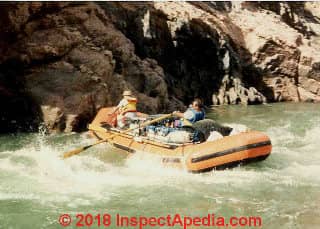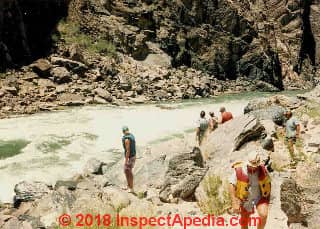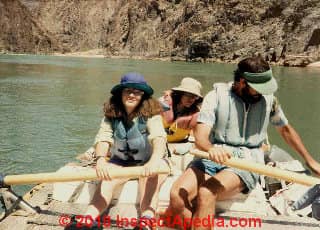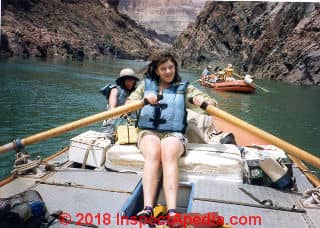 House Rock Rapids
House Rock Rapids
Close call in the Grand Canyon, 1991
Dedicated to Mara Friedman, now Mara Gieseke, who was carried in the river past House Rock Rapids in the Grand Canyon, 1991.
Here is true story I think about a lot but that I have rarely told.
I don't have photos of this actual rock, for reasons that will be evident as the story unfolds.
Which Way to Go at Dread Rock
We spent a couple of weeks going down the Colorado river - back in 1991, when it carried more water at greater depths than today.
Me, wife Laura Waterman now Sigfried, and teen daughter Mara Elise Friedman now Gieseke.
One morning we decided to have a more leisurely day so we hopped a ride with Mike who was oaring the baggage raft - bigger than the others - figuring it'd be a very tranquil day-float.
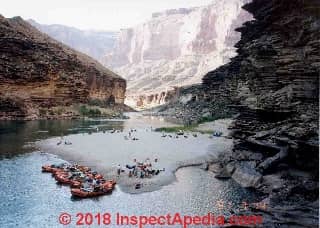 Sections of the Colorado river can be quite tranquil. [Click to enlarge any image]
Sections of the Colorado river can be quite tranquil. [Click to enlarge any image]
Mid-morning we passed a large boulder that was shining like a sun. An aluminum canoe had broad sided the boulder, filled with water, and wrapped around the rock.
Later current and rocks and floating logs had pounded the canoe until it was perfectly flat, silver-plating the boulder's surface as a shiny aluminum sphere in the river. The image of the power to plate a canoe so perfectly against solid rock was not lost on us.
Down river we approached a huge rectangular boulder in the river known as House Rock, also referred to as Dread Rock or rarely as BedRock. This boulder is as big as a house, you can dread it, or you may be bedded onto it. It depends. The current splits. Reading the river, it looks as if you should pass on the right.
The House Rock, or in today's naming, Rock House rapids hole will easy flip any raft.
On our raft trip in 1991 Mike began to head to the right side of House Rock. That passage really looked like the more obvious route with better water.
The other oarsmen were screaming across the water GO LEFT GO LEFT!
House Rock Rapids, aka "House Rock" and also "Dread-Rock" is a famous spot for flipping rafts. Going right is certain disaster. The other oarsmen and oarswomen knew that. You have to go left.
Mike back-oared in a panic. It was too late. We got broadside on the house-sized rock.
The downstream side of the raft began to slide up the rock, tipping the raft at an increasingly dangerous angle.
Mike yelled HIGH SIDE - you know what that means. Everyone should immediately leap to the up-rock side of the raft to try to avoid a flip.
As someone who plans ahead I was high sided in a flash. It was not enough.
Mara froze on the downside edge of the raft. She gripped whatever was nearby as a handhold.
The oarsman's seat was atop a large flat diamond plate base.
River water quickly filled and sagged the raft bottom and continued to pour in.
Suddenly a wave hit Laura and she was swept under the diamond plate - she was trapped, completely under water, between the diamond plate and the ballooning raft bottom, with just one hand sticking out.
I came off the high side, grappled Laura's hand and even if it meant dislocating her shoulder I dragged her out and threw her to the high side. Laura lay choking, regaining her breath. Alive.
The river raged. Another, larger wave surged towards us.
A giant living lion's paw, the wave swept towards our angled-up raft, wrapped itself around Mara, and clawed her right off of the raft, sweeping her into the churning water.
We had been lectured about such a moment.
Alan, Jeff, Donna, Eric, and the other guides had told us repeatedly: "If someone falls into the river, DO NOT jump in after them. All that will do is increase the number of people who drown."
Mike was fighting the rock and Colorado current. Time began to crawl. Seconds became un-measurable moments. Moments were eons.
With great skill, Alan had taken his raft downstream from Dread Rock, backed into the downstream eddy, climbed a good twenty feet up atop the rock, and had the emergency HELP float-cushion.
This rectangular boat cushion sported the word HELP in large letters, we also used this device as a sign for privacy when one of us was using our river-camping toilet.
This was not toilet-time.
With a shout Alan threw the life preserver upstream, hoping it would float down to Mara. The preserver arced overhead and we watched it land a tremendous distance upstream.
Time's rate returned for an interval as the HELP cushion flashed knowingly-by on our right.
Mara had disappeared completely under water. Writing this today, decades later, remembering that moment makes me pause as my eyes fill with tears.
She was gone.
Time stopped.
You know from your own water experience that upstream of a larger rock the current can boil and curl back on itself. There may be an upstream current behind and down from Dreadrock, but upstream on this day was a maelstrom.
We waited.
Suddenly Mara popped up, released for a moment from the Colorado's grip. The back-eddy had taken her upstream and in the current she was paused, bobbing idly mid-stream.
In seconds the river would take her again.
We could not hear one another but I could see her eyes. They were wider than saucers. She was absolutely terrified.
There was time, in this quantum space, to think. Ok so she's going to drown. By god she will not drown alone.
Leaving Laura on the high side and Mike trying to push the raft back down, I leapt into the water and swam upstream to Mara.
We joined hands and were immediately sucked under water, the current rolling us over and over. We were no more than bits of river-debris.
In moments we were dashed against the side of DreadRock. We bobbed up, gasping for breath.
Four hands scratched at the algae-slick side of the rock seeking a hold. There was none.
Before we could even get a breath we were back under water and being rolled about.
We were drowning. The most primitive human drives took control. Grasping in crazy desperation to push herself upwards, Mara clutched my throat in a choke-hold. Lost of all humanity, I, her father, fought back like a demon. Her hold was broken and and the river took her away. A drowning person has no altruism.
We were swept along under water. We both wore life jackets but their buoyancy was nothing to the Colorado.
Onwards in freezing blackness we rolled and thrashed.
The Colorado has some of the highest-class rapids in the world. What makes it safer and easier for amateurs than its sisters further south is that the rapids are intermittent, broken by some flat water.
In quantum month's time later both of us were given up by the river. We popped to the surface about 100 yards downstream from dreadrock, twenty feet apart, both of us panting and gasping for breath.
We were pulled onto Jeff's raft and taken ashore. The other raftsmen had all beached rafts.
Everyone was so shaken that we stopped for a time. Mara and I sat against the vertical side of the canyon wall, thawing in the sun beating against the hot rock surface, grinning to be alive.
From time to time, when Mara has faced difficulty, as she has faced and overcome it entirely on her own, I claimed to her "Well this is hard and terrible, but you went left at DreadRock, and you survived that. You can face anything." She has.
Above, Mara and me, after DreadRock - House Rock Rapids, 1991. Incredibly, notwithstanding the incredible force of the river, in a fluke, my red hat from the Big Tomato restaurant in Poughkeepsie stayed on my head for the entire event.
- DF 2018/02/09
Below: The big baggage raft with Mike at the oars, followed by scouting Lava Falls on the Colorado river in 1991.
Today in 2018 House Rock Rapid is mostly sandbar, especially at low water. The huge house-sized rock we encountered in 1991 is nowhere in sight. At this writing on 2018/02/09 at 12:00 the current flow in the Colorado river was 137,700 CFS.
Current recommended passable water flow rates at House Rock Rapid extend from 4000 CFS to a maximum of 50,000 CFS.
But in the summer of 1991 water was high, the sand bar was deep under water, and there was a huge house-sized boulder near the center of the river's path. Later the river later took away that House-sized Rock.
Below: Mara, Laura Waterman, and Colorado River Raftsman and guide Alan in 1991.
Here is what riverbrain.com says about House Rock Rapids:
4-7 on the grand canyon scale. III- to IV+ on the international scale. This rapid becomes harder at lower water. The river pushes towards the left wall across a sandbar at the top of the rapid. This creates a series of wave trains running down the left wall.
Problem is there is a very large hole at the bottom left of the rapid. Enter at the left of the rapid by the wall and pull right to miss the hole. If you pull to soon you will hit the shallow sand bar area on river right. Rock House rapids hole will easy flip any raft. This is considered one of the harder rapids on Marble Canyon. - Source: https://www.riverbrain.com/river_rapid/show/220 retrieved 2018/02/09
- Colorado River - Grand Canyon, House Rock Rapid, Rapid Details, riverbrain.com, retrieved 2018/02/09, original source: https://www.riverbrain.com/river_rapid/show/220
- Webb, Robert H., Theodore S. Melis, and Richard A. Valdez, OBSERVATIONS OF ENVIRONMENTAL CHANGE IN
GRAND CANYON, ARIZONA [PDF], (2002) U.S. Geological Survey
Information Services
Building 810
Box 25286, Federal Center
Denver, CO 80225-0286 retrieved 2018/02/09, original source: https://pubs.usgs.gov/wri/wri024080/pdf/WRIR4080.pdf
Excerpt:
The increase in frequency of debris flows will hasten a long-postulated change in the longitudinal profile of the river; without dam releases significantly higher than power plant capacity, the river will eventually attain an exaggerated pool-drop configuration. Implications of such a trend might be that navigation of rapids becomes generally more difficult, and in some cases, the river may become impassable.
Continued aggradation of the river channel by coarse sediment delivered during debris flows will likely fill-in deeper pools above and below rapids, while also enhancing the size of eddies.
...
Continue reading POETRY & SHORT FICTION, Daniel Friedman or select a topic from the closely-related articles below, or see the complete ARTICLE INDEX.
Suggested citation for this web page
HOUSE ROCK RAPIDS at InspectApedia.com - online encyclopedia of building & environmental inspection, testing, diagnosis, repair, & problem prevention advice.
Or see this
INDEX to RELATED ARTICLES: POETRY & SHORT FICTION, Daniel Friedman
Or use the SEARCH BOX found below to Ask a Question or Search InspectApedia
Ask a Question or Search InspectApedia
Try the search box just below, or if you prefer, post a question or comment in the Comments box below and we will respond promptly.
Search the InspectApedia website
Note: appearance of your Comment below may be delayed: if your comment contains an image, photograph, web link, or text that looks to the software as if it might be a web link, your posting will appear after it has been approved by a moderator. Apologies for the delay.
Only one image can be added per comment but you can post as many comments, and therefore images, as you like.
You will not receive a notification when a response to your question has been posted.
Please bookmark this page to make it easy for you to check back for our response.
IF above you see "Comment Form is loading comments..." then COMMENT BOX - countable.ca / bawkbox.com IS NOT WORKING.
In any case you are welcome to send an email directly to us at InspectApedia.com at editor@inspectApedia.com
We'll reply to you directly. Please help us help you by noting, in your email, the URL of the InspectApedia page where you wanted to comment.
Citations & References
In addition to any citations in the article above, a full list is available on request.
- In addition to citations & references found in this article, see the research citations given at the end of the related articles found at our suggested
CONTINUE READING or RECOMMENDED ARTICLES.
- Carson, Dunlop & Associates Ltd., 120 Carlton Street Suite 407, Toronto ON M5A 4K2. Tel: (416) 964-9415 1-800-268-7070 Email: info@carsondunlop.com. Alan Carson is a past president of ASHI, the American Society of Home Inspectors.
Thanks to Alan Carson and Bob Dunlop, for permission for InspectAPedia to use text excerpts from The HOME REFERENCE BOOK - the Encyclopedia of Homes and to use illustrations from The ILLUSTRATED HOME .
Carson Dunlop Associates provides extensive home inspection education and report writing material. In gratitude we provide links to tsome Carson Dunlop Associates products and services.



